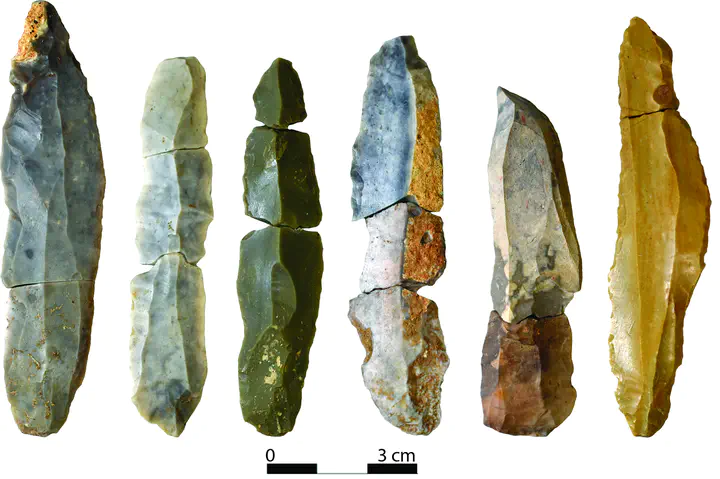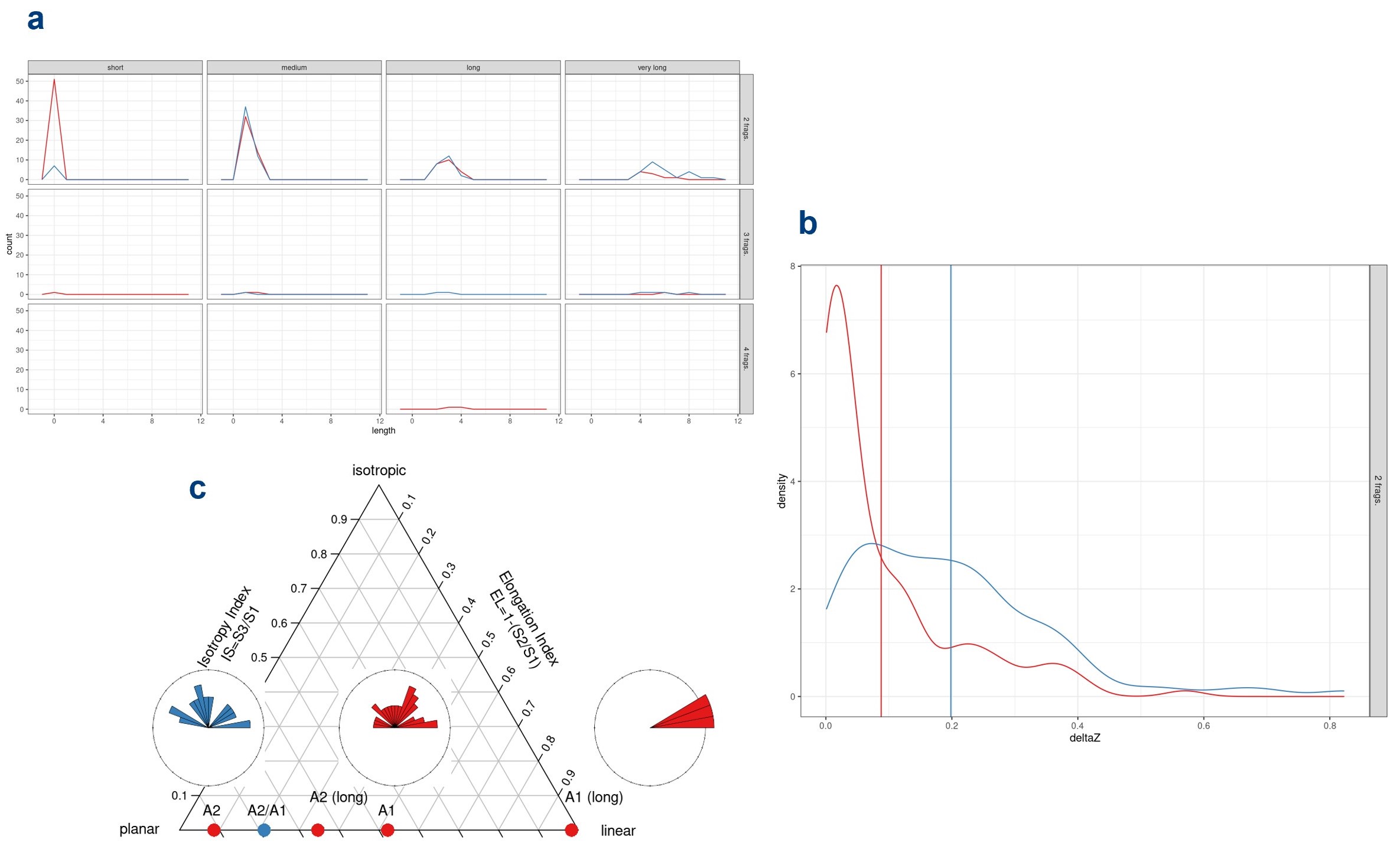Linking blades: a systematic refitting analysis of blade fragments from the Protoaurignacian sequence of Fumane Cave
 Image credit: Armando Falcucci
Image credit: Armando Falcucci1. Introduction and Research Aim
Due to their rather complex formation processes, unraveling the taphonomic history of cave sites is critical in studying cultural change over time (Goldberg et al., 1993). In the specific case of the Aurignacian technocomplex, particular attention is needed in assessing the integrity of lithic assemblages recovered from multi-stratified sites, as its diachronic and regional variability is often used to model the modes of dispersal and adaptation of H. sapiens across Europe (Anderson et al., 2015).
At Fumane Cave (Venetian Prealps, northeastern Italy), recent techno-typological assessments allowed Falcucci et al. (2020) to hypothesize that the main traits of the earliest phase of the Aurignacian (i.e., the Protoaurignacian) lasted for several millennia, without being replaced by the Early Aurignacian.
Here, we assess the degree of integrity of the lithic assemblages using a lithic taphonomic approach and spatial analysis to verify the previous findings and provide a better narrative of the onset of the Upper Paleolithic in the region.
2. Materials and Methods
This study focuses on the whole Upper Paleolithic sequence of Fumane, from the earliest Protoaurignacian layer A2, dated to about 41 ky cal BP (Higham et al., 2009), up to the uppermost layer D1e, dated to the Heinrich Event 3 (López-García et al., 2015).
We employ a break connection method (Bordes, 2000) to systematically quantify the links within and across layers. We screened all lithics and laid on several tables the identified blade fragments (n = 3,254) sorted according to lithological and technological features (Fig. 1). All possible connections were thus systematically tested by three independent analysts (AF, FZ, MDL).

Information on the horizontal and vertical provenience of the refitted blanks was then used to assess the reliability of the stratigraphic sequence and quantify the integrity of the lithic assemblages in the different areas of the excavation using multivariate spatial analysis (DG) in the software environment of R (R Core Team, 2022).
3. Results of the Refitting Activity
A total of 509 blade fragments have been successfully connected, for an overall refitting rate of 15.6%. Connections belong to a total of 247 blanks and they are composed of two (n = 234), three (n = 11), and four (n = 2) fragments.
Inter-layer connections represent a common occurrence, with an overall percentage of 45.2%. They are very frequent in the D-layers. Intra-layer connections exceed the 50% only in a few cases, with A2 and D3b alpha having the highest rates (Fig. 2).

Fig. 3 shows the distribution of connected fragments across the stratigraphy. Remarkably, A2 contains fragments that connects with all layers of the sequence. Inter-layer connections appear to be more frequent between layers that are in stratigraphic proximity.

4. Spatial Analysis
Spatial analyses were conducted on 506 (out of 509) connected blade fragments with valid point geometries retrieved from present and historical documentation. We investigated the horizontal and vertical distributions, as well as the relative distance and orientation patters of intra- and inter-layers connections between blade fragments.
A2 is the most extensively excavated layer and the one with the highest number of intra-layer connected blanks (Fig. 4). Out of the 12 sampled layers, four of them (D3b, D3a+b, D3a+b sabbie, D1c) yielded no intra-layer refitting blade fragments. The spatial distribution of refits in A2 is rather homogeneous, while the distribution in A1 is mostly localized outside of the cave dripline. All the 12 sampled layers yielded inter-layer refitting blade fragments, with at least one fragmented being recovered in A2 (Fig. 5). With A2 being extensively excavated, the spatial distribution of A2 inter-layer refits is quite homogeneous within the different excavated areas.


Refitting links were sorted in short (< 0.5m), medium (0.5-2.1m), long (2.1-4m), and very long (> 4m) horizontal distances (Cziesla, 1990) and analyzed accordingly. Intra- and inter-layer refitting blanks made of two fragments show comparable distributions in the medium and long distance classes (Fig. 6a). Unsurprisingly, short distances are more frequent in intra-layer refitting blanks. On the other hand, very long distances are only slightly more frequent in inter-layer refitting blanks. Blanks made of three fragments show comparable distribution in the medium and very long distance classes. Notably, and despite the one blank made of four connecting fragments from A2 is classified as long, it actually links three spatially adjacent layers.

The vertical distances between intra- (red) and inter-layer (blue) refitting blanks range between 0 and 0.8m, with right skewed distributions (Fig. 6b). Despite intra-layer blanks are characterized by less vertical dispersion (mean = 0.1m), inter-layer blanks still show relatively low values (mean = 0.2m).
Finally, the orientation of the intra- and inter-layer refitting links show clear planar trends (Fig. 6c), thus excluding the role of massive, chaotic processes. A clear linear pattern with E-NE orientation emerges in the A1 intra-layer sample when subsetting long and very long links (>2.1 m). The rose diagrams for the A2 and A2/A1 sub-samples of long links show peaks towards E, NE, N-NW, and NW. Nevertheless, the inter-layer A2/A1 sample does not show more anisotropy than the intra-layer samples.
5. Discussion and Ongoing Research
So did post-depositional events have a significant role in the formation of the lithic assemblages at Fumane Cave?
Our results suggest minor post-depositional reworking processes of the stratigraphic sequence at Fumane Cave and contribute to disentangle the complex stratigraphic relations in such a long-term archaeological excavation.
They will ultimately allow us to identify the optimal area of the excavation to be sampled for a more robust techno-typological study.
References
Anderson L., Bon F., Bordes J.-G. et al. (2015) Relier des espaces, construire de nouveaux réseaux : aux origines du Protoaurignacien et des débuts du Paléolithique supérieur en Europe occidentale. In N. Naudinot, L. Meignen, G. Binder et al. (eds.): Les systèmes de mobilité de la Préhistoire au Moyen Âge XXXVe rencontres internationales d’archéologie et d’histoire d’Antibes, pp. 57-73. Éditions APDCA, Antibes.
Bordes J.G. (2000) La séquence aurignacienne de Caminade revisitée : l’apport des raccords d’intérêt stratigraphique. Paléo, 12: 387-407.
Cziesla E. (1990) On refitting of stone artefacts. In E. Cziesla, S. Eickhoff, N. Arts et al. (eds.): The Big Puzzle: International symposium on refitting stone artefacts, Monrepos, pp. 9-44. Holos, Bonn.
Falcucci A., Conard N.J. & Peresani M. (2020) Breaking through the Aquitaine frame: A re-evaluation on the significance of regional variants during the Aurignacian as seen from a key record in southern Europe. J. Anthropol. Sci., 98: 99-140.
Goldberg P., Nash D.T. & Petraglia M. (1993) Formation processes in archaeological context. vol 17. Prehistory Press, Madison.
Higham T., Brock F., Peresani M. et al. (2009) Problems with radiocarbon dating the Middle to Upper Palaeolithic transition in Italy. Quat. Sci. Rev., 28: 1257-1267.
López-García J.M., dalla Valle C., Cremaschi M. et al. (2015) Reconstruction of the Neanderthal and Modern Human landscape and climate from the Fumane cave sequence (Verona, Italy) using small-mammal assemblages. Quat. Sci. Rev., 128: 1-13.
R Core Team (2022) R: A language and environment for statistical computing. R Foundation for statistical computing, Vienna.